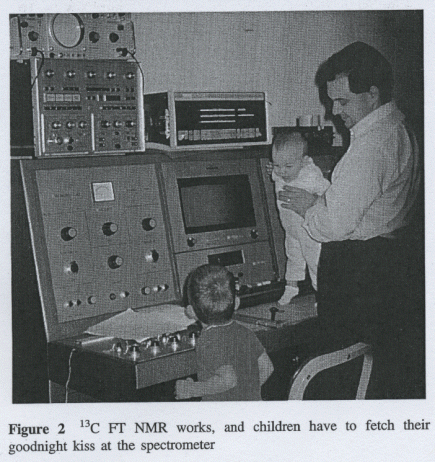The story of the first FTNMR Spectrometers
The four threads come together
The Mnemotron story, the PDP-8 story, the FFT story and the FTNMR story might seem unrelated, but these stories coalesce in a beautiful way. Here is an account of how it happened. It is from the multi volume Encyclopedia of Nuclear Magnetic Resonance (ISBN 0471 95839 5). One of the volumes is entitled "Historical Perspective." and it is devoted to the personal recollections of almost everyone connected to NMR. It is fun reading. What follows is a synopsis of Tony Keller's contribution. It is his account of how the first carbon 13 spectra were made. Keller's mission, as an employee of Bruker Analytische Messtechnik in 1969, was to create a useful multinuclear NMR spectrometer. When he first heard about about the Fourier spectroscopy results of Ernst and Anderson it was, in his words, like "experiencing a beautiful sunrise." Bruker was already using the Nicolet 1070 signal averager. When Keller learned that the Nicolet 1070/PDP-8 system could do FFTs, he became very interested and he bought one immediately.
 Here is Tony Keller and two unnamed assistants. In this picture, the PDP-8 and
the 1070 rest uneasily side by side on the console of the world's first multinuclear,
proton decoupled, fourier transform NMR spectrometer. This version of the PDP-8 is now
much smaller because it is now a TTL machine. It is also 3 orders of magnitude cheaper
than an IBM 7090 though it is doing the same job. The signal to noise ratio was improved
spectacularly due to Fellgett's advantage and proton decoupling. This is the setup that
produced the carbon 13 spectra presented at the Anaheim Convention Center in Los Angeles
in 1969.
Here is Tony Keller and two unnamed assistants. In this picture, the PDP-8 and
the 1070 rest uneasily side by side on the console of the world's first multinuclear,
proton decoupled, fourier transform NMR spectrometer. This version of the PDP-8 is now
much smaller because it is now a TTL machine. It is also 3 orders of magnitude cheaper
than an IBM 7090 though it is doing the same job. The signal to noise ratio was improved
spectacularly due to Fellgett's advantage and proton decoupling. This is the setup that
produced the carbon 13 spectra presented at the Anaheim Convention Center in Los Angeles
in 1969.
The software running in the 1070/PDP-8 system was crude. I know, because I wrote it. It was also slow, yet it was faster than trucks carrying loads of punchcards. Bruker eventually bought one hundred such systems from Nicolet. The 1070/PDP-8 had a killer application.